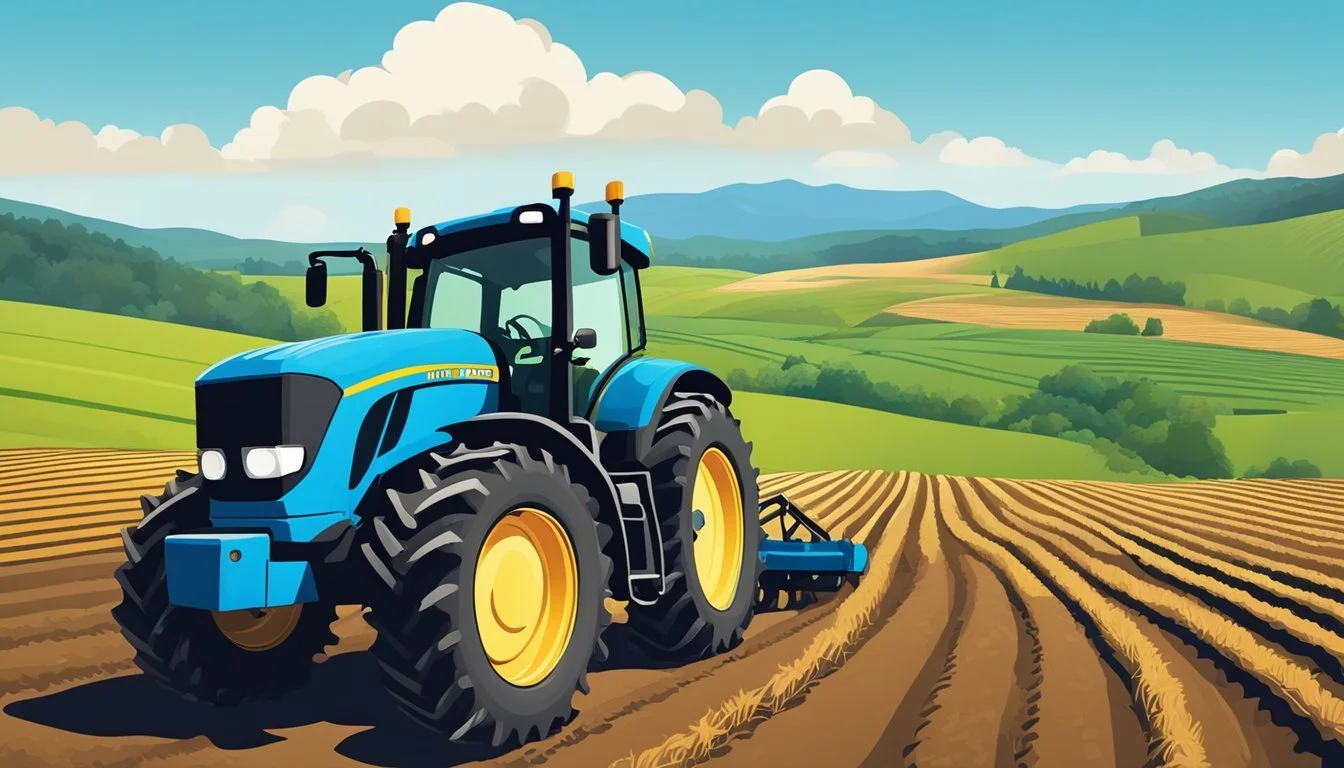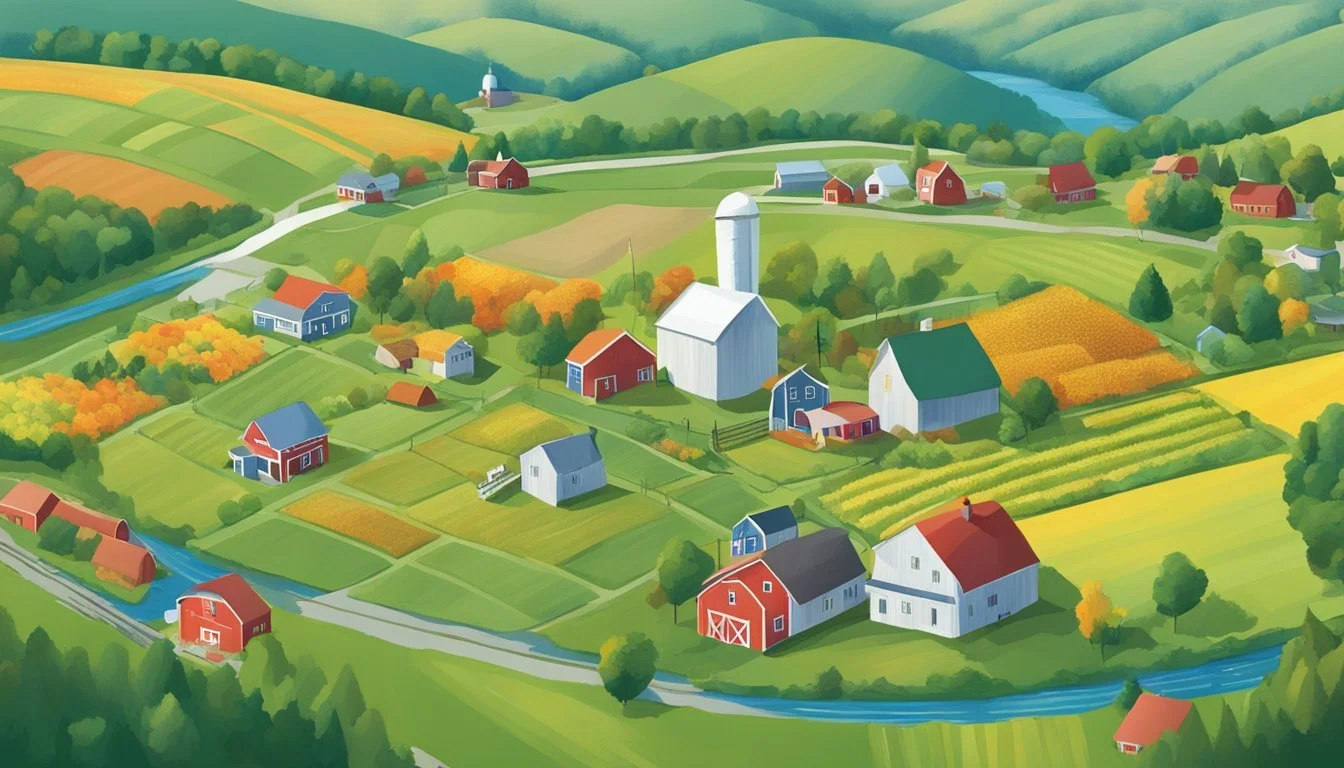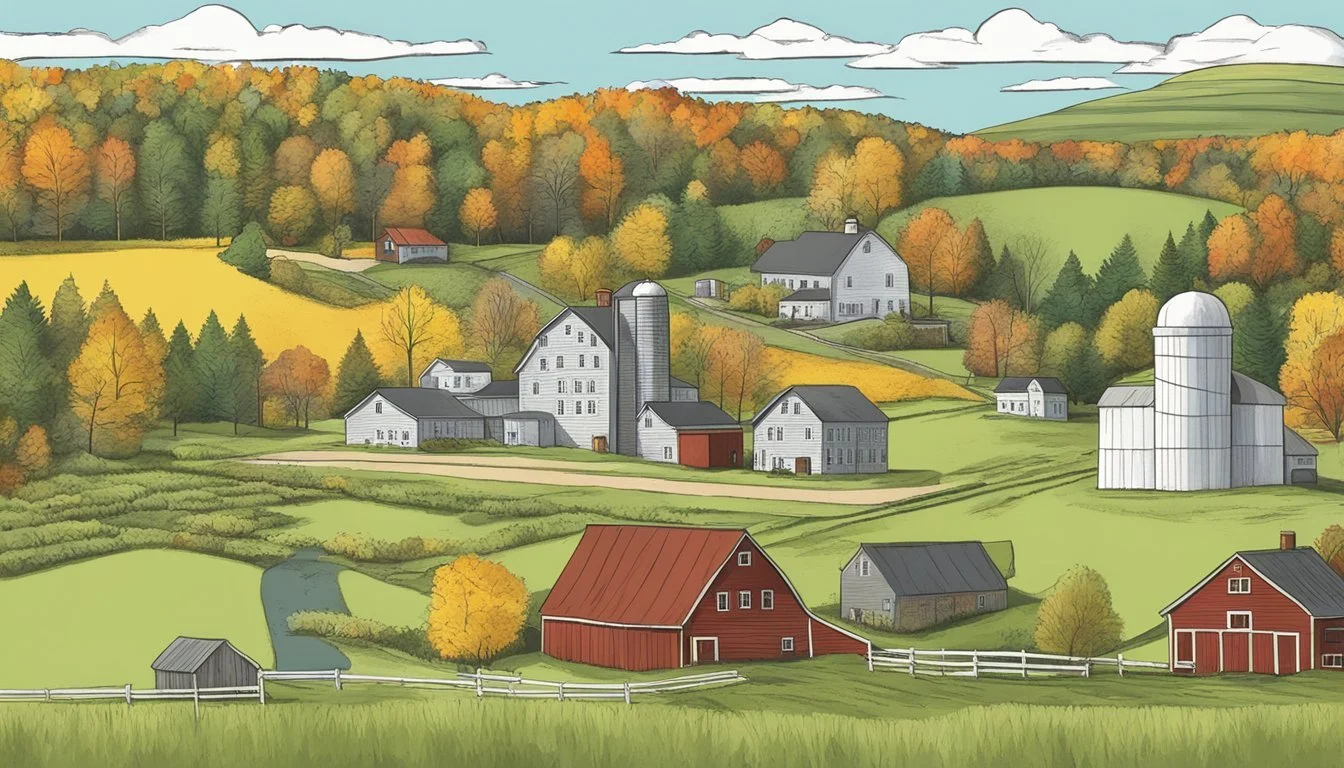Right to Farm Law in Vermont
Understanding Its Implications for Agriculture and Community
The Right to Farm Law in Vermont serves to protect and promote agricultural activities by safeguarding farming operations from nuisance lawsuits. This legal framework has its roots in the recognition of Vermont's agricultural lands as crucial, irreplaceable resources that are pivotal for the preservation of the state’s agricultural heritage. Enacted in 1982, the law reflects the state's commitment to maintain and foster an environment conducive to farming, acknowledging the industry's role in the local economy and cultural identity.
Since its inception, Vermont has experienced changes in its agricultural landscape. While the state has seen a reduction in farmland by about 24 percent, there has been an increase in the number of farm operations. This juxtaposition highlights the evolving nature of agriculture in the region, reflecting shifts toward potentially smaller, more diverse, or differently structured farming enterprises. The Right to Farm Law, therefore, not only protects existing farms but also supports the emergence and sustainability of new agricultural modalities.
The law in Vermont is part of a broader tapestry of states' right-to-farm statutes and contains particular stipulations that define what constitutes agricultural activity. These activities encompass the cultivation of land for various purposes, ranging from food and fiber production to the raising and management of livestock. In reinforcing the foundation for agricultural practices, the law aims to ensure that farms can operate without the undue burden of legal disputes over nuisances, providing they adhere to generally accepted agricultural practices.
Historical Background
The Historical Background of Vermont's Right to Farm laws reveals a dedicated effort to protect the state's agricultural heritage and adapt to the evolving agricultural landscape.
Origins of Right to Farm in Vermont
In 1981, Vermont legislators enacted the state's Right to Farm law, underscored by a recognition of agricultural lands as essential resources demanding protection. This legislation aimed to safeguard farmers from nuisance lawsuits that could arise from the standard operations of their farms. Vermont's approach was to preserve the continuity and vitality of its agricultural sector, which has always been a cornerstone of the state's economy.
Evolution of Agricultural Legislation
Over the years, Vermont's legislative framework has been responsive to changes within the farming industry, reflecting the dynamic nature of agricultural practices and their relationship with both the environment and society. Updates to the legislation have addressed various aspects of farming activities, from livestock raising to crop production, ensuring that the legal structures in place support the likely continuance of farming even as external challenges emerge.
By analyzing the historical context of Vermont's Right to Farm laws and their amendments, the ongoing commitment to a robust and sustainable agricultural sector is evident. The legislation acts as a legal buffer that allows for both farming growth and community harmony within the state.
Key Components
Vermont's Right to Farm Law outlines specific provisions that support the state’s agricultural sector. This framework serves to define acceptable farming practices, detail the scope of protection afforded to farmers, and establish the role of the state in preserving agricultural interests.
Definition of Agricultural Practices
The State of Vermont recognizes agricultural practices as those that are necessary for the on-ground everyday operations of a farm. This includes, but is not limited to, activities such as planting, cultivating, and harvesting crops, as well as raising livestock. The law stipulates that these practices must be consistent with accepted customs and standards established by the agricultural community.
Scope of Protections
Vermont's Right to Farm Law provides protections to farmers and their operations, particularly shielding them from nuisance lawsuits. These protections are predicated on the fact that the farming operations are lawful, follow best management practices, and are established prior to any conflict that arises.
Lawful: Farm must be in compliance with relevant local, state, and federal law.
Best Management Practices: Farm operations must adhere to established guidelines that are designed to balance farm productivity with environmental conservation.
Preexisting: Farms in operation before nearby non-agricultural development are particularly protected.
Role of the State
The State has a significant role in the implementation of the Right to Farm Law. It ensures:
The continued viability of agriculture as an important industry in Vermont.
Education and mediation services between farmers and their non-farming neighbors.
Legislative updates that reflect the evolving needs of the state’s agricultural community and practices.
By maintaining a legislative environment that promotes understanding and proactive communication, the state supports a robust agriculture sector which is recognized as an irreplaceable resource.
Legal Implications
The legal landscape for farmers in Vermont is significantly influenced by the state's Right to Farm Law, which aims to protect agricultural activities from nuisance suits. This law introduces a rebuttable presumption to shift the burden of proof, thus affecting how legal disputes are approached.
Nuisance Suits
In Vermont, Right to Farm laws are designed to safeguard farmers from nuisance suits, which may arise when longstanding agricultural operations are challenged by new neighbors or changes in land use. An essential aspect of these laws is to allow farms to operate without the undue burden of legal complaints related to the smells, sounds, and other consequences of normal farm operations.
Rebuttable Presumption
The rebuttable presumption is a legal advantage granted to farmers, indicating that farm operations cannot be deemed a nuisance if they adhere to generally accepted agricultural practices and are established prior to surrounding non-agricultural land uses. However, this presumption is not absolute and can be countered with appropriate evidence showing that the operation does not meet established legal standards.
Burden of Proof
Shifting the burden of proof plays a pivotal role in legal proceedings associated with the Right to Farm laws. It demands that the plaintiff, often a neighbor or a community member, must demonstrate that the farm operation significantly interferes with their use and enjoyment of their property, rather than the farmer proving their operation is not a nuisance. Attorneys representing clients in these cases must provide convincing evidence to overcome the presumption that favors farmers.
Economic and Social Impacts
Vermont's Right-to-Farm laws have distinct economic and social repercussions, directly influencing farmland sustainability and community dynamics across the state.
Impact on Farms and Farmland
Farms in Vermont benefit from Right-to-Farm legislation as it reinforces the economic foundation of agricultural operations. Despite the law's protection, Vermont has experienced a 24 percent reduction in farmland since its enactment in 1982, which raises concerns about land preservation. However, paradoxically, the number of farm operations has expanded by 8 percent, indicative of a diversification in the agricultural sector.
Economic Impact on Farmland:
Protects land use for agriculture from non-farming real estate development pressures.
Encourages the preservation of agricultural lands, recognized as "unique and irreplaceable resources."
Community Relations
The Right-to-Farm Law influences community relations primarily around land use and nuisance issues. While it offers a shield for farmers from certain nuisance lawsuits brought by neighbors and other landowners, it also necessitates a balance between farm activities and community standards.
Farmers and Neighbors:
Can lead to tensions when agricultural practices intersect with residential lifestyles.
Places emphasis on the need for farmers and non-farming neighbors to coexist peacefully.
The implementation of the Right-to-Farm Law in Vermont is designed to secure economic viability for farms, which are integral to the state's identity, while also engaging in an ongoing dialogue with the community to maintain harmonious relationships.
Environmental Considerations
Vermont's Right to Farm Law intersects significantly with environmental considerations. It aims to protect valuable farmland while ensuring that agricultural operations comply with environmental laws and embrace good agricultural practices.
Environmental Law and Agriculture
Agriculture in Vermont operates within the framework of environmental law, which includes statutes designed to protect land, water, and air quality. The Agency of Agriculture works in conjunction with the environmental statutes to ensure that farming practices do not adversely affect the state’s natural resources. The Right to Farm Law, in particular, supports farmers in maintaining agricultural activities without the threat of nuisance lawsuits, provided they adhere to accepted agricultural practices that respect environmental standards.
Good Agricultural Practices
To safeguard Vermont's unique farmland, farmers are encouraged to follow Good Agricultural Practices (GAP). These practices serve as guidelines for environmental stewardship, food safety, and sustainable farm management.
Soil Management: Maintain soil fertility and structure by implementing crop rotations, cover cropping, and conservation tillage.
Water Use: Employ efficient irrigation systems to conserve water and protect water quality.
Pest Management: Utilize integrated pest management (IPM) strategies to reduce reliance on chemical pesticides.
Waste Management: Implement practices to manage and recycle organic waste and reduce pollution.
Farmers who adhere to these practices are better positioned to comply with the Right to Farm Law, promoting environmental health and sustainable agriculture.
Challenges and Controversies
Vermont's Right to Farm Law has led to notable challenges stemming from the broad scope of activities it protects. These challenges primarily manifest in conflicts with neighboring properties and in public health and safety concerns.
Conflicts with Neighboring Properties
The expansive definition of protected agricultural activities has sometimes resulted in friction between farms and neighboring properties. Residents have expressed concerns related to noise, odor, and other disturbances, leading to nuisance suits. In some cases, neighbors argue that farm operations significantly affect their quality of life and property values. However, farmers are often shielded by the Right to Farm Law, which grants a rebuttable presumption against nuisance claims, provided the agricultural activities are consistent with good farming practices and established prior to surrounding non-agricultural uses.
Public Health and Safety Concerns
The Right to Farm Law's protection extends to various farm operations which may raise public health and safety concerns. This includes the management of large-scale livestock operations and the application of pesticides and fertilizers. Critics argue that without stricter regulations, there could be negative impacts on local ecosystems, water sources, and public health. The law aims to balance these concerns with the need to support and sustain Vermont’s agricultural sector. However, the interpretation of what constitutes reasonable agricultural practices and the latitude given to farmers can lead to disputes over whether the existing legal framework adequately protects against potential health and safety risks.
State Versus Local Authority
In Vermont, the Right to Farm Law establishes a framework where state authority can pre-empt local ordinances, ensuring uniform agricultural practices and protections statewide.
Preemption by State Law
The state of Vermont's Right to Farm Law provides that agricultural activities, as long as they comply with federal, state, and local laws, are entitled to a rebuttable presumption that they are not a public or private nuisance. This effectively means the state law can preempt local laws when it comes to agricultural practices. Consequently, local regulations become secondary to state laws, which are designed to protect and preserve farming as a vital industry.
Role of Local Governments
Local governments still play a critical role within the boundaries set by the state authority. They enforce local zoning ordinances that must align with the state and federal regulations. Though local agencies cannot contravene state provisions, they can implement measures to address the specific needs of their communities, as long as they do not impose stricter regulations on farming practices than those at the state level.
Right to Farm and Public Experience
The Right to Farm law in Vermont plays a crucial role in shaping the relationship between agricultural practices and the public's experience of rural life.
Impact on Public Welfare
The Right to Farm laws are designed to preserve the agricultural landscape by protecting farms from nuisance lawsuits that may arise from the public's proximity to farming activities. Society benefits from these laws as they maintain a vital rural economy and ensure the continuity of agricultural resources. Moreover, farmers are safeguarded against claims that might otherwise threaten farming operations, which are often essential for local food production and public welfare.
Legal Framework:
Ensures that farms existing before changes in land use are protected.
Encourages coexistence between farms and nearby communities.
Educational Programs and Outreach
Programs and outreach efforts are implemented to bridge the gap between the farming community and society. They aim to cultivate an understanding of agricultural practices, addressing concerns related to noise, smells, and other byproducts of farming that can affect the daily lives of individuals.
Key Components:
Educational programs elucidate the importance of agriculture and clarify misconceptions.
Advocacy groups foster communication between farmers and non-farmers.
Resources offered may include farm tours, workshops, and informational pamphlets that provide insights into the agricultural sector's impact on welfare and society. Such initiatives help in building a well-informed public that recognizes the value and challenges of farming livelihoods.
Future Directions
As Vermont looks ahead, the integration of innovative agricultural practices and modifications to its legal frameworks are pivotal to the advancement of agriculture. These changes are expected to reflect in the upcoming Farm Bill and state legislation.
Innovations in Agricultural Practices
Agriculture in Vermont is poised to embrace new technologies and methodologies that can sustainably increase productivity and environmental stewardship. Innovations such as precision farming, which utilizes GPS and IoT (Internet of Things) technologies, allow farmers to optimize inputs and monitor crop health on a detailed level. Additionally, there is a push toward organic farming and the use of non-GMO crops, aligning with the increasing consumer demand for natural and environmentally friendly products. These advancements not only support the growth of agricultural operations but also help to maintain the integrity of Vermont's unique and irreplaceable farmlands.
Adjustments in Legal Framework
Legislation plays a crucial role in shaping the future of agriculture in Vermont. The ongoing development of Vermont's Right-to-Farm Law is indicative of a legal framework adjusting to protect farmers and agricultural activities. As aforementioned, the anticipated amendments aim to protect agricultural activities that comply with generally accepted agricultural practices from nuisance suits. This legal protection encourages farmers to adopt innovative practices without the fear of litigation, fostering a more resilient and adaptive agricultural sector. Additionally, the presence of Vermont advocates on the Senate Agriculture Committee during the formulation of the new Farm Bill demonstrates Vermont's commitment to playing a significant role in national agricultural policy development.










